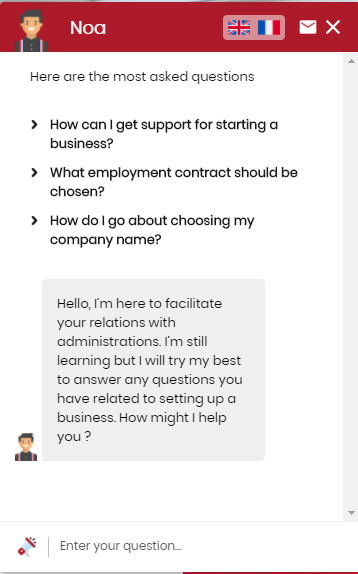
As businesses and individuals are increasingly moving towards new technologies, it is time for public services to adapt too. The objective? To become all-digital by 2022. A complicated yet necessary project, further highlighted by the current Covid-19 crisis. Public service bodies need to be modernised in order to offer a quality service, that can be accessed anywhere, at any time.
However, only 39% of French administrations have reported using digital technology in a substantial way to manage their user relationship*. This transformation is therefore in early stages and must be accelerated so that public services can meet future challenges. This is essential for both users as well as administration and local authority employees.
Multiple challenges
Citizens today are interconnected, and administrations must adapt to this social change. The challenges are multiple – to provide easy access to information, simplify administrative procedures, improve productivity to the lighten employee workload, etc. By changing their mode of operation, public services can rapidly gain in efficiency. Of course, those who stand to benefit the most from this are the users, but unfortunately not everyone is in the same boat. Indeed, this is the main limitation of digital transformation, and the biggest challenge – reaching everyone. Some people have little or no access to digital tools, or to the training they would need to tackle these new processes alone. This part of the population needs support and guidance, to ensure that these procedures are as accessible and easy-to-understand as possible, for everyone.
The French state has begun to move towards a paper-free system through “modernisation” reforms. The next step is the adoption of various new technologies, particularly those based on AI. This article will now focus on the benefits of chatbots and their use in public services.
The role of chatbots in the digital transformation of public services
- Relieving administrations and facilitating internal processes
The French administration is often criticised for its slow pace and limited opening hours. Yet public services are increasingly in demand. They are easily overwhelmed and processing a file that should take a few minutes can sometimes take weeks. Which is the advantage of a conversational robot – a first point of contact to provide answers to simple and recurring user questions, and to escalate to a competent agent (livechat or telephone) if necessary.
“40 to 60% of user requests to local authorities do not require any special skills, such as looking up the opening hours for a swimming pool or the address of a recycling centre,” Yannick Sourisseau explains, journalist and editor-in-chief of Ville Intelligente Mag.
For certain departments, automating the processing of simple and recurring requests could save a considerable amount of time. The relationship between the user and administration would then become smoother and the service provided of a better quality. The entity contacted could then give a clear and efficient answer in a more reasonable timeframe.
When associated with other databases and internal software, chatbots can also facilitate internal processes and user procedures. This is referred to as RPA (Robotic Process Automation) chatbots, enabling requests to be handled with no human intervention, although human supervision remains essential. This could include subscriptions, changing information in a file, editing a document, statements, etc. All saving considerable time for both the user and the agent.
- Providing a continuous, easy to access service
Chatbots can be accessed at any time of the day, every day of the year. This enables public services to smooth the pace of requests and lighten the load at high-traffic hours. Chatbots are available all the time and also on all communication channels – websites, mobile apps or messaging apps. Chatbots favour a transversal way of working between departments and administrations by providing a single point of contact for all their questions.
Users benefit from an immediate, homogenous response, 24/7, and therefore have a better experience and image of the service provided.
- Facilitating administrative procedures and access to information
A chatbot’s main role is to help users find information. A lot of administrations implement bots to make administrative procedures, that can sometimes be daunting and complicated, easier to understand. Take for example Noa (“Nous orienter dans l’Administration”), a chatbot for business owners that answers their questions about administrative procedures when setting up a business – tax and legal obligations, patents, how to register a trademark, financing, recruiting staff, etc.
This conversational robot was implemented by the Île-de-France prefecture, grouping together information and procedures for more than 10 administrations at a single point of contact. This enables business owners to gain a better understanding of the procedures and legal obligations linked to their activity and to become more autonomous and less dependent on an administration’s response time.
Since NOA was implemented in March 2019, business owners have asked more than 6,000 questions, with an 80% accuracy rate. It should also be noted that when lockdown measures were announced, users asked more than double the amount of questions compared to the previous period, with a notable peak during the first 3 weeks.

This chatbot is the perfect example of a transversal tool used by completely separate departments and administrations. As well as providing useful information, this type of chatbot could speed up administrative procedures in the future by carrying out actions directly via the bot, such as submitting a file.
- Encouraging “selfcare”
72% of consumers prefer to find answers to their questions without contacting customer services.** Most customers turn to the internet first, whether via an online search or directly on the company’s website. They expect to be able to find an answer by themselves, in real time, at any time of day or night. Most companies have therefore made content available to their customers, so that they can be more autonomous – tutorials, documentation, guides, FAQs, chatbots, community support platforms, etc. Users are therefore used to using these kind of tools and expect the same from public services.
The lockdown period further highlighted this observation, as it became necessary to find new ways to communicate while people were isolated at home.
For example, schools and universities had to adapt quickly to continue teaching their classes. The national education system has already started providing schools with new ways to teach and communicate, that are more in line with pupils’ habits and behaviour, particularly by developing digital platforms promoting distance learning.
Jules, the virtual homework helper for secondary school students, implemented by the CNED in January 2019, is an example of this. Specialising in French, Maths, History and Geography, Jules is regularly updated by teachers and provides answers to questions about the curriculum from Year 7 (11-12 year olds) to Year 10 (14-15 year olds). It also provides methodology sheets, advice, quizzes, tips and videos. During lockdown, the chatbot experienced a peak in traffic with nearly 235,000 interactions per month, and currently has nearly 70,000 users. This provides valuable and free support for students, making them more autonomous and motivated.
Chatbots can also be useful to help those who are digitally illiterate because they process natural language.
- Making everyday life easier for employees – internal chatbots
Public organisations can also create a chatbot to help employees by automatically answering their questions relating to human resources, IT, legal issues, etc. For example, the Val d’Oise Conseil Départemental implemented a HR chatbot in January 2020 to answer more than 4,000 employees’ most frequent questions and facilitate access to existing information and documents. This chatbot was created to replace a telephone call with an innovative and accessible tool. As such, Dimo, a digital assistant for Val d’Oise employees, provides generic and contextualised answers on topics such as leave and absences, social benefits, training, internal mobility, remote working, etc.
Then there is the city of Nîmes and its IT chatbot to help employees with Outlook, as they implemented a new internal messaging system. The chabot aims to make users more autonomous, but also to free up support services who were handling a large number of questions by email, telephone or in person. The city of Nîmes is now thinking of other ways their chatbot could develop employee autonomy in the future.
Chatbots are far more than a passing trend. They have gradually become an essential tool for departments that are overwhelmed by incoming requests – customer relations, human resources, IT, and more recently, public services who, in the midst of digital restructuring, are already reaping the benefits.
*Panorama of the digital transformation of the French public sector by Artimon, 2018
**Forrester, 2017





